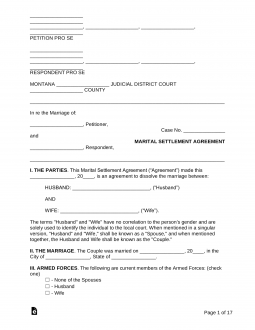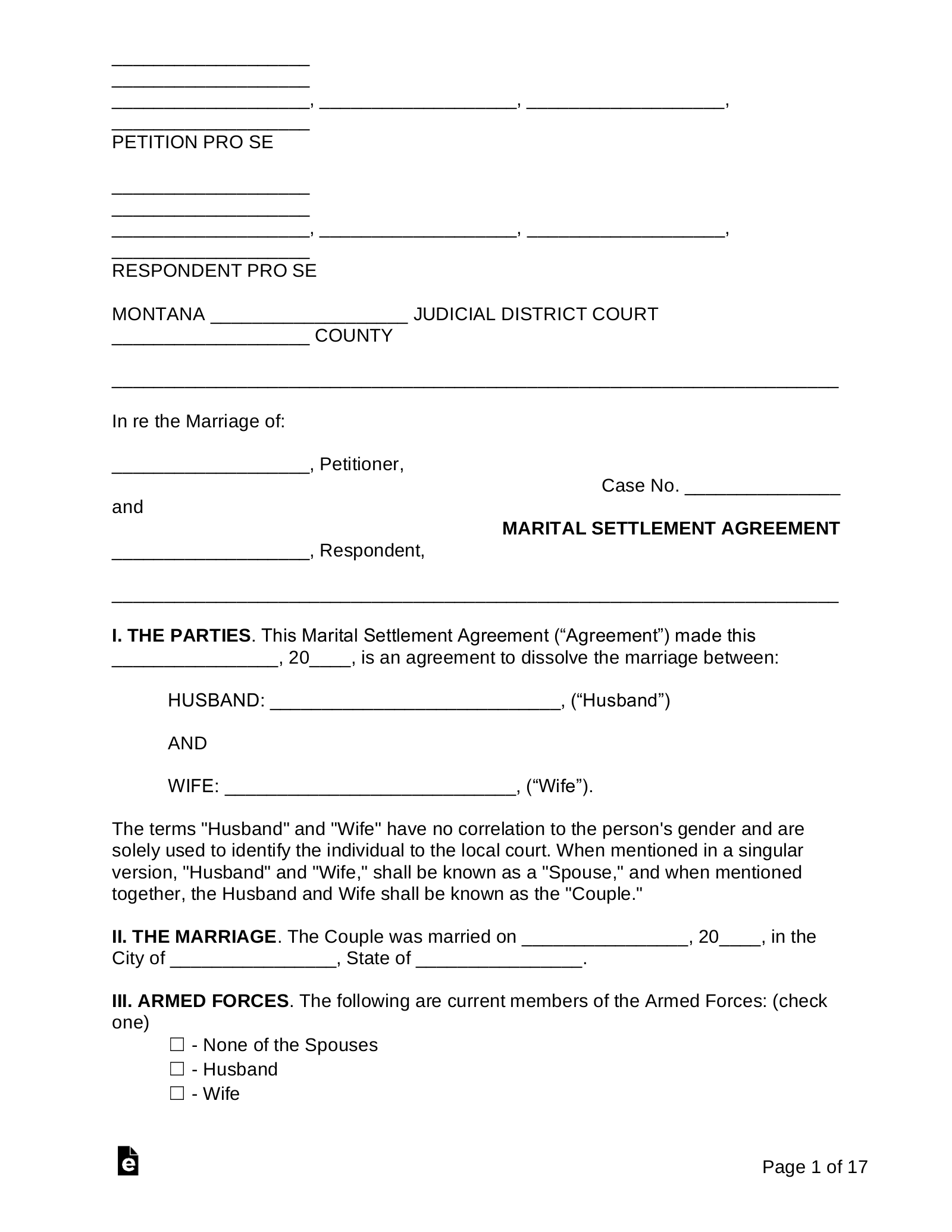Updated November 28, 2023
A Montana marital settlement agreement is used by divorcing couples to enter into a binding arrangement in the distribution of their property, assets, and child custody. By agreeing on the terms of their separation, couples can control the outcome of their divorce instead of allowing a judge to determine the division of their property and other interests. If either spouse wishes to receive alimony or child support from the other party, they must include the payment amount and schedule for these in the contract as well. Once the document has been executed by both parties, it becomes legally binding; however, the terms of the arrangement can be amended in accordance with contract law.
Table of Contents |
Divorce Laws
Statutes – Montana Code Annotated – Title 40, Chapter 4 (Termination of Marriage, Child Custody, Support)
Alimony (§ 40-4-203) – The court may award alimony, referred to as a “maintenance order” in state courts, to either spouse; however, the support-seeking spouse must prove that they have insufficient means to reasonably support themselves. The following criteria are observed when assigning alimony:
- The financial resources of the party seeking maintenance
- The education of the party seeking maintenance
- The standard of living established during the marriage
- The duration of the marriage
- The age and condition of the spouse seeking maintenance
- The ability of the other spouse to support themselves and the spouse seeking maintenance
Alimony Calculator – calculators.law
Child Support (§ 40-4-204) – Either or both spouses may be ordered to pay child support to the other party in accordance with state child support guidelines.
Child Support Calculator – mtchildsupport.com, calculators.law, alllaw.com
Division of Property (§ 40-4-202) – Montana is an equitable distribution state, which means that the court is required to apportion the couple’s property and assets in a just and fair manner in consideration of each spouse’s circumstances and the facts of their case. Equitable distribution is not always an equal fifty-fifty split.
Grounds for Divorce (§ 40-4-104 and § 40-4-107) – Couples can file for divorce by declaring one (1) of the following factors as their grounds for divorce:
- Irretrievable breakdown of the marriage
- The couple has lived apart for a period of more than one hundred eighty (180) days
- Serious marital discord
Interim Support (§ 40-4-121) – During divorce proceedings, either spouse can request an order for temporary maintenance (alimony) and/or child support.
Residency (§ 40-4-104(1)(a)) – At least one (1) spouse must have been a state resident for at least ninety (90) days immediately prior to beginning legal action for their divorce.
Separation (§ 40-4-104(1)(b)(i)) – To file for divorce on the grounds of separation, spouses must live in separate residences for a period longer than one hundred eighty (180) days.
Divorce Forms
- Where to File – District Court in County of Residence
- Filing Fee – $200
- How Long Does it Take? At least twenty (20) days
The below forms are in Microsoft Word (.doc) format.
Uncontested Divorce with No Children:
- How to File for Joint Dissolution without Children
- Joint Petition for Dissolution without Children (MP – 115)
- Financial Disclosure and Proposed Property Distribution (MP – 500)
- Income and Expenses (MP – 510)
- Additional Income (MP – 510-A)
- Additional Expenses (MP – 510-B)
- Request for Hearing and Statement of Compliance with Financial Disclosure (MP – 701)
- Order Granting Hearing on Dissolution without Children (MP – 714)
- Dissolution Decree without Children (MP – 713)
- Consent to Entry of Decree (MP – 730)
- Request for Waiving Court Fees
- Vital Statistics Reporting Form (.pdf)
Uncontested Divorce With Children:
- How to file for Joint Dissolution with Children
- Joint Petition for Dissolution with Minor Children (MP – 116)
- Attachments – MP – 113-B, MP – 113-C, MP – 113-D, MP – 113-E
- Proposed Parenting Plan (MP – 300)
- Description of Existing Medical Coverage (MP – 300-G)
- Notice to Person Not Named (MP – 407)
- Financial Disclosure and Proposed Property Distribution (MP – 500)
- Income and Expenses (MP – 510)
- Additional Income (MP – 510-A)
- Additional Expenses (MP – 510-B)
- Request for Hearing and Statement of Compliance with Financial Disclosure (MP – 701)
- Order Granting Hearing on Dissolution with Children (MP – 702)
- Dissolution Decree (MP – 703)
- Consent to Entry of Decree (MP – 730)
- Request for Waiving Court Fees
- Vital Statistics Reporting Form (.pdf)
How to File for Divorce in Montana (5 steps)
- Complete Divorce Paperwork
- Marital Settlement Agreement
- File Divorce Paperwork with District Court
- Attend Hearing and Final Decree
- Name Change
1. Complete Divorce Paperwork

If a couple is in agreement regarding the terms of their divorce (the legal term in Montana is “dissolution of marriage”) they can file a joint petition for divorce as co-petitioners. This type of uncontested divorce bypasses the need for either party to be served a summons or named as a defendant in the case. It is also the quickest and least complicated option for divorcing couples.
The couple will need to download and complete the following forms:
- Joint Petition for Dissolution – Without Children/With Children
- Optional Attachments for Petition with Children – MP – 113-B, 113-C, 113-D, 113-E
- Financial Disclosure and Proposed Property Distribution
- Income and Expenses – Must be completed by both spouses
- Optional additional forms: Additional Income/Additional Expenses
- Proposed Parenting Plan – Couples with children only
- Description of Existing Medical Coverage – Couples with children only
- Request for Hearing and Statement of Compliance with Financial Disclosure
- Order Granting Hearing on Dissolution – Without Children/With Children
- Dissolution Decree – Without Children/With Children
- Vital Statistics Reporting Form – Must be filed before a decree can be entered
The couple will need to make at least three (3) copies of each form.
2. Marital Settlement Agreement
To aid the couple in completing their Proposed Property Distribution, they can fill out a Marital Settlement Agreement. This document covers all of the necessary terms for divorcing couples and is often completed with legal mediation to make an agreement that is fair to both spouses.
3. File Divorce Paperwork with District Court

The couple must file all of the required paperwork for their joint petition with the Clerk of the District Court for the county in which either spouse is a resident. The petitioners will be given a hearing date and case number by the clerk, who will charge a base filing fee of $200 (the payment and pre-payment of other fees may also be required). In the event that the couple is unable to pay the associated court costs, they can complete and file a Request for Waiving Court Fees. The court clerk should be provided with pre-addressed stamped envelopes for both spouses if they wish to receive copies of their decree by mail.
4. Attend Hearing and Final Decree

Both spouses are required to attend their divorce hearing unless one (1) of them filed a Consent to Entry of Decree to waive their required attendance. The judge will review the couple’s proposed property distribution and parenting plan, interview each spouse, and if everything is in order, sign the Final Dissolution Decree at which juncture the divorce will be final (in many cases the petitioner will need to file the decree with the court clerk).
5. Name Change
Either spouse may legally change their last name by including the name change in their Petition for Dissolution of Marriage. Once the divorce has been finalized, certified copies of the divorce decree can be used as proof that their name was legally changed when updating personal accounts and official records. To change their name after a divorce is final, individuals will need to open a new case by filing a Petition for Name Change with their district court.


